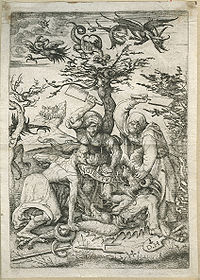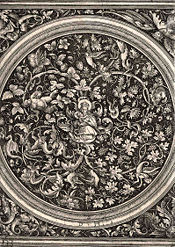
Daniel Hopfer
Encyclopedia

Germany
Germany , officially the Federal Republic of Germany , is a federal parliamentary republic in Europe. The country consists of 16 states while the capital and largest city is Berlin. Germany covers an area of 357,021 km2 and has a largely temperate seasonal climate...
artist who is widely believed to have been the first to use etching
Etching
Etching is the process of using strong acid or mordant to cut into the unprotected parts of a metal surface to create a design in intaglio in the metal...
in printmaking
Printmaking
Printmaking is the process of making artworks by printing, normally on paper. Printmaking normally covers only the process of creating prints with an element of originality, rather than just being a photographic reproduction of a painting. Except in the case of monotyping, the process is capable...
, at the end of the fifteenth century. He also worked in woodcut
Woodcut
Woodcut—occasionally known as xylography—is a relief printing artistic technique in printmaking in which an image is carved into the surface of a block of wood, with the printing parts remaining level with the surface while the non-printing parts are removed, typically with gouges...
.
Life
The son of Bartholomäus Hopfer, a painter, and his wife Anna Sendlerin, Daniel moved to AugsburgAugsburg
Augsburg is a city in the south-west of Bavaria, Germany. It is a university town and home of the Regierungsbezirk Schwaben and the Bezirk Schwaben. Augsburg is an urban district and home to the institutions of the Landkreis Augsburg. It is, as of 2008, the third-largest city in Bavaria with a...
early in his life, and acquired citizenship there in 1493.
In 1497 he married Justina Grimm, sister of the Augsburg publisher, physician and druggist Sigismund Grimm. The couple had three sons, Jörg, Hieronymus and Lambert, the last two of who carried on their father's profession of etching, Hieronymus in Nuremberg
Nuremberg
Nuremberg[p] is a city in the German state of Bavaria, in the administrative region of Middle Franconia. Situated on the Pegnitz river and the Rhine–Main–Danube Canal, it is located about north of Munich and is Franconia's largest city. The population is 505,664...
and Lambert in Augsburg. The two sons of Jörg, Georg and Daniel (junior), also became distinguished etchers, patronised by no less than the Emperor Maximilian II, whose successor, Rudolf II, raised Georg to the nobility
Nobility
Nobility is a social class which possesses more acknowledged privileges or eminence than members of most other classes in a society, membership therein typically being hereditary. The privileges associated with nobility may constitute substantial advantages over or relative to non-nobles, or may be...
.
Daniel was trained as an etcher of armour
Armour
Armour or armor is protective covering used to prevent damage from being inflicted to an object, individual or a vehicle through use of direct contact weapons or projectiles, usually during combat, or from damage caused by a potentially dangerous environment or action...
. There are only two proven examples of his own work on armour: a shield from 1536 now in the Royal Armoury museum (La Real Armería) of the Royal Palace of Madrid
Royal Palace of Madrid
The Palacio Real de Madrid is the official residence of the King of Spain in the city of Madrid, but it is only used for state ceremonies. King Juan Carlos and the Royal Family do not reside in the palace, choosing instead the more modest Palacio de la Zarzuela on the outskirts of Madrid...
and a sword in the Germanisches Nationalmuseum
Germanisches Nationalmuseum
The Germanisches Nationalmuseum is a museum in Nuremberg, Germany. Founded in 1852, houses a large collection of items relating to German culture and art extending from prehistoric times through to the present day...
of Nuremberg. An Augsburg horse armour in the German Historical Museum, Berlin
Berlin
Berlin is the capital city of Germany and is one of the 16 states of Germany. With a population of 3.45 million people, Berlin is Germany's largest city. It is the second most populous city proper and the seventh most populous urban area in the European Union...
, dating to between 1512 and 1515, is decorated with motifs from Hopfer's etchings and woodcut
Woodcut
Woodcut—occasionally known as xylography—is a relief printing artistic technique in printmaking in which an image is carved into the surface of a block of wood, with the printing parts remaining level with the surface while the non-printing parts are removed, typically with gouges...
s, but this is no evidence that Hopfer himself worked on it.
The etching of metals with acid was known in Europe from at least 1400, but the elaborate decoration of armour, in Germany anyway, was an art probably imported from Italy around the end of the 15th century—little earlier than the birth of etching as a printmaking technique. Although the first extant dated etchings are the three by Albrecht Dürer
Albrecht Dürer
Albrecht Dürer was a German painter, printmaker, engraver, mathematician, and theorist from Nuremberg. His prints established his reputation across Europe when he was still in his twenties, and he has been conventionally regarded as the greatest artist of the Northern Renaissance ever since...
of 1515, and despite the fact that none of his works are dated, stylistic evidence suggests that Daniel Hopfer was using this technology as early as 1500.

Daniel died in Augsburg in 1536. His achievement was widely recognized during his time, and in 1590 he was posthumously named as the inventor of the art of etching in the imperial patent of nobility bestowed upon his grandson Georg.
Works
Daniel Hopfer's early etchings were done in line-work, but he and his sons soon developed more sophisticated techniques, referred to by armour historians as the Hopfer style. Applied to prints, this produced silhouetted designs on a black ground, doubtless by multiple bitings of the plates. The technically-demanding procedure seems to have been both delicate and labour-intensive, and no other artists are known to have used this exact method. Their plates were all iron, rather than the copper that the Italians later introduced..jpg)
Old master print
An old master print is a work of art produced by a printing process within the Western tradition . A date of about 1830 is usually taken as marking the end of the period whose prints are covered by this term. The main techniques concerned are woodcut, engraving and etching, although there are...
to designs for goldsmith
Goldsmith
A goldsmith is a metalworker who specializes in working with gold and other precious metals. Since ancient times the techniques of a goldsmith have evolved very little in order to produce items of jewelry of quality standards. In modern times actual goldsmiths are rare...
s, secular subjects such as peasant
Peasant
A peasant is an agricultural worker who generally tend to be poor and homeless-Etymology:The word is derived from 15th century French païsant meaning one from the pays, or countryside, ultimately from the Latin pagus, or outlying administrative district.- Position in society :Peasants typically...
s, military figures (especially Landsknecht
Landsknecht
Landsknechte were European, predominantly German mercenary pikemen and supporting foot soldiers from the late 15th to the late 16th century, and achieved the reputation for being the universal mercenary of Early modern Europe.-Etymology:The term is from German, Land "land, country" + Knecht...
s), portraits of contemporary worthies, mytholological and folkloric themes, the sheer range of the Hopfers' productions are both remarkable and unique, designed to appeal to a clientele far wider than the metalsmiths who bought his patterns to create their wares. However, the Hopfer family did not hesitate to plagiarize the work of their contemporaries: of Daniel's 230 known prints, 14 are copies of other masters, mainly Mantegna, whilst only a minority of Hieronymus' 82 plates are his original work—no less than 21 are copies of Durer's
Albrecht Dürer
Albrecht Dürer was a German painter, printmaker, engraver, mathematician, and theorist from Nuremberg. His prints established his reputation across Europe when he was still in his twenties, and he has been conventionally regarded as the greatest artist of the Northern Renaissance ever since...
works, and around 30 others are copies from Jacopo de' Barbari
Jacopo de' Barbari
Jacopo de' Barbari, sometimes known or referred to as de'Barbari, de Barberi, de Barbari, Barbaro, Barberino, Barbarigo or Barberigo , was an Italian painter and printmaker with a highly individual style. He moved from Venice to Germany in 1500, thus becoming the first Italian Renaissance artist...
, Raimondi
Marcantonio Raimondi
Marcantonio Raimondi, also simply Marcantonio, was an Italian engraver, known for being the first important printmaker whose body of work consists mainly of prints copying paintings. He is therefore a key figure in the rise of the reproductive print...
and Altdorfer among others.
In the next century, a distant relative of the Hopfers, David Funck (1642–1705), a bookseller of Nuremberg, acquired 230 of the Hopfers' iron plates, and reprinted these under the title Operae Hopferianae, adding a somewhat crudely scratched number, known as the Funck number, to each one, thus creating a second state
State (printmaking)
A state, in printmaking, is a different form of a print, caused by a deliberate and permanent change to a matrix such as a copper plate or woodblock ....
of the hitherto unretouched plates.
A further print run of 92 plates was made in 1802 by the publishers C.W. Silberberg of Frankfurt under the title Opera Hopferiana. The quality of the prints is a tribute to the care with which the Hopfer family maintained these rust-prone plates, many of which are in the Berlin print cabinet
Print room
A print room is either a room or industrial building where printing takes place, or a room in an art gallery or museum, where a collection of old master and modern prints, usually together with drawings, watercolours and photographs, are held and viewed. The latter meaning is the subject of this...
today.

